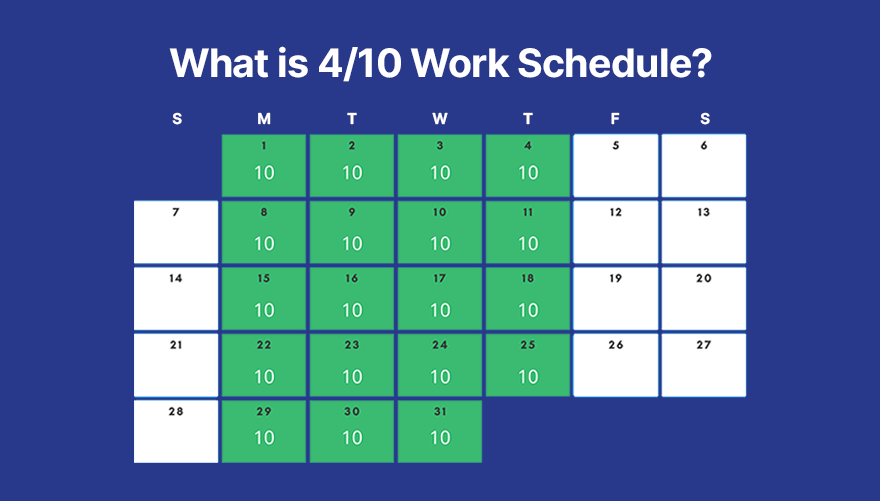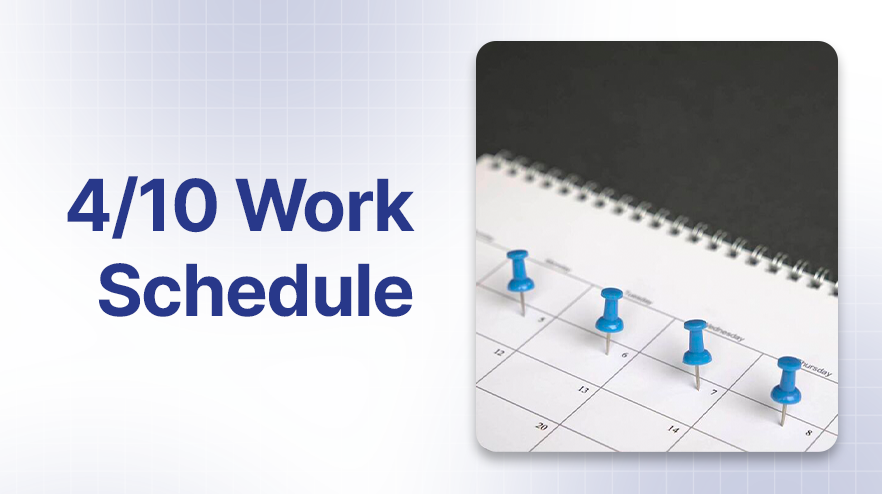Table of Contents
In a modern business workplace, working smarter is better than working harder. Modern businesses always seek innovation to boost productivity, employee work-life balance, optimize operations, and achieve better results.
Whether SMBs, startups, or MNCs, the 4/10 Work Schedule can be the perfect alternative to the traditional 9-5 model. It became an innovative choice post-pandemic among global companies, like Panasonic, Kickstarter, Elephant Ventures, Bit.io, and Buffer, to boost productivity, flexibility, work-life balance, and reduce burnout.
While 4/10 sounds like a smarter alternative to a traditional 9-5 work schedule, it poses several challenges, like a complicated work schedule, long working hours, and employee resistance.
Businesses must leverage remote employee monitoring software to track employees’ attendance and performance. It automatically tracks employees’ attendance, integrates with communication channels, and creates an online sheet based on real-time insights.
If you are a business owner or manager looking for a comprehensive guide. You are right on the spot.
This blog will guide you through the Pros and Cons of the 4/10 model and how your company can leverage it.
What is a 4/10 Work Schedule?
The 4/10 work schedule refers to a 4-day work week. The compressed work model follows the 40-hour workweek model. However, unlike the traditional work model of 8 hours, it follows a 10-hour extended schedule from Monday to Thursday.
This compressed working schedule has 4 days with an extra weekend off. The extra days off allow employees to relax, recharge, and spend quality personal time.
It offers flexibility, boosts employee productivity, and maintains a work-life balance.

Track Your Team’s Productivity—Without Micromanaging
Easily monitor attendance, project hours, and real-time performance as you transition to a 4/10 workweek.
Businesses can implement and tweak different models: compressed, hybrid, and reduced hours to ensure a perfect alternative to traditional 5/8 work models.
Types of 4/10 Work Models:
1. Compressed Schedule:
It refers to compressed work hours. For example, companies can schedule a 4-day schedule with 10 hours daily, time off on Friday, or alternate weekdays.
2. Reduced Hours
The model focuses on reducing working hours to 32 hours a week, instead of 40. This flexibility boosts productivity and reduces the potential risk of burnout.
3. Hybrid Model
The hybrid model focuses on flexibility in work schedule and working from home to boost productivity and work-life balance. It also allows companies to switch between the compressed schedule and reduced-hour models to experiment with what is best for them.
The Rising Demand for a 4-Day/ Week Schedule: Why Businesses Should Leverage It

Post-pandemic, the demand for a 4/10 work schedule is being adopted by nations like New Zealand, Spain, and Japan, with global giants, such as DNS filters, Buffer, and Panasonic, to leverage its flexibility. It attracts top talent, is cost-effective, and improves work-life balance.
1. Attracts Top Talents:
The 4/10 work schedule attracts top talent for its flexibility and extended weekends. Most modern workforces prefer a compressed schedule as an incentive rather than a bigger pay cheque. 67% of Gen Z prefer companies with a 4-work schedule while searching for new jobs.
2. Boosted Productivity
Businesses with a 4/10 work schedule experienced a boost in employees’ performance and productivity. It improves focus and time management on an ongoing project and reduces the potential for burnout.
The extra week off and flexible work schedule help employees concentrate on their projects and improve productivity.
3. Work-Life Balance
The compressed workdays allow employees to earn an extra week off to spend quality time with family, explore their hobbies, and relax. This flexibility reduces burnout and improves work-life balance.
It also reduces absenteeism, as employees often seek leave for personal work and relaxation. The extended weekends balance personal and professional life, improve quality, and focus on work.
4. Better Work Quality
The 4/10 work schedule allows employees to focus on their work without distraction and potential burnout. They feel more motivated and efficiently manage time with fewer workdays. It also reduces the risk of errors and supports better schedule planning to improve overall team performance.
5. Convenience and Cost-Effective
The compressed workdays offer convenience and a cost-effective option for employees and businesses. It provides a cost-effective and time-saving approach by saving on commuting. Additionally, businesses save on utility bills and overhead expenses.
Challenges of Business Counter while Implementing a 4/10 Work Schedule

While the 4/10 work model offers benefits over the traditional model, it enhances productivity and work-life balance. Businesses might find it difficult to implement it. They often face challenges in optimization, burnout due to longer hours, and employee resistance.
1. May Not Be Suitable for All Industries
The 4/10 work model might not be suitable for various sectors that require 24/7 services, like healthcare, retail, hospitality, and customer care. The long week off and complicated schedule disturb workflow and customer satisfaction.
2. Potential Burnout Due to Longer Workdays
Longer working hours cause fatigue, reduced focus, and burnout, especially in roles that demand physical and mental strength. Employees may decline in productivity, which can impact quality and customer satisfaction. Additionally, long commutes can stretch it out longer, leading to a work-life imbalance.

Make Your 4/10 Transition Smooth and Data-Driven
Use smart tools to evaluate productivity, gather feedback, and make schedule decisions with confidence.
3. Complicated Schedule Management
Implementing 4/10 work might be complicated, especially for a large team. Proper schedule management requires careful planning to ensure full-week coverage. Miscommunication and employee resistance can cause project delays, conflicts, and reduced team availability during peak hours. Businesses must employ a reliable employee tracker and policy to ensure collaboration and a smooth workflow.
4. Legal and Regulatory Compliance
Regulatory bodies might restrict maximum work hours, overtime, payroll management, and mandatory breaks. Companies must ensure that a 4/10 schedule complies with regulatory compliance, HIPAA, OSHA, and GDPR. Non-compliance can lead to penalties, legal disputes, and employee resistance.
3 Secret Tips for Implementing a 4/10 Work Schedule

Switching to a 4/10 work model from a traditional work schedule requires proper planning to improve productivity and employee satisfaction. Businesses must implement these three secret tips to ensure a smooth operation.
1. Assess Business Objectives
Before implementing a 4/10 schedule, assess whether it is convenient for your business. Conduct an extensive review of business objectives, industry type, customer satisfaction, and team to ensure it fits.
Try the work model to gather insights through regular feedback. This ensures the 4/10 model supports work-life balance and scalability.
2. Set Transparent Policy for Change
Clear communication and policy are the secret to optimizing a 4/10 schedule shift. Make a clear policy about working hours, breaks, and availability during days off. Address complications like overtime, performance metrics, and emergency support. Transparent policy builds trust and sets guidelines.
3. Leverage Employee Monitoring Tools
Businesses must leverage employee monitoring tools to measure performance and evaluate the new work model. It tracks performance, accountability, and productivity trends during a 4/10 schedule. A manager can make a data-driven strategy to ensure smoother transitions.
Read more: What Is Swing Shift Schedule
Conclusion
The 4/10 work schedule offers numerous advantages to employees as well as businesses. If you want to revolutionize work culture, adapt to modern-day work dynamics, and rethink productivity, this work schedule is a perfect alternative to traditional 9-5 work models. It enhances productivity, reduces burnout, boosts morale, and improves work-life balance. However, its successful implementation requires careful planning, transparent policies, and effective monitoring.
That’s where wAnywhere can help. wAnywhere is a one-stop solution that ensures a smooth transition to a modern 4/10 work schedule. It tracks time, real-time activity, project status, productivity, and seamlessly integrates with existing HRM and communication tools.
wAnywhere helps your business turn the idea of a 4/10 work model into a reality without compromising the quality of your operations and results. It manages longer workdays without burnout to ensure team availability, accountability, and compliance. It enables leaders to track outcomes, spot challenges early, and build trust in a schedule that works for both the company and its people.
wAnywhere is compatible with macOS, Windows, Linux, and Chromebook in just 3 minutes. It also offers 14-day FREE trials and built-in 15+ tools to streamline and optimise your transition. It provides audits and time-off management to ensure compliance with HIPAA, GDPR, and local labor laws during the transition.

Ready to Embrace the 4/10 Work Model Without the Guesswork?
Let wAnywhere help you plan, track, and optimize your new schedule—seamlessly and securely.













